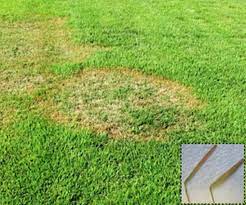
Home / Here on Earth / Systemic Control of Brown Patch Fungus
Brown Patch is a serious disease affecting warm grasses. The disease is most common between November and May when the temperature is below 80℉. Turfgrasses like zoysiagrass, bermudagrass, and St. Augustine grass are vulnerable to this brown patch disease.
Increased thatch and nitrogen fertility levels often result in breakouts of brown patches. It is typically not seen in the summer months. Infection is stimulated by excessive irrigation, rainfall, or increased periods of high humidity leading to the leaves being constantly wet for 48 hours or more.
Signs of Brown Patch Fungus
 The fungus causes infection in the leaf area nearest to the soil, consequently killing the leaf. A dark, soft rot develops at the leaf’s base and the leaves can effortlessly be pulled by the stem. The bottom of a pulled leaf contains a rotting odor. Roots remain unaffected by this pathogen. This disease generally starts as small patches (around 1 ft in diameter) that turn yellow and then brown, reddish brown, or straw-colored as the leaves begin to die.
The fungus causes infection in the leaf area nearest to the soil, consequently killing the leaf. A dark, soft rot develops at the leaf’s base and the leaves can effortlessly be pulled by the stem. The bottom of a pulled leaf contains a rotting odor. Roots remain unaffected by this pathogen. This disease generally starts as small patches (around 1 ft in diameter) that turn yellow and then brown, reddish brown, or straw-colored as the leaves begin to die.
Patches can stretch to a few feet in diameter. It is common to observe rings of brown or yellow turf with possibly healthy turf in the center. Turf at the outer border of a patch may look wilted and dark. This disease is generally mistaken for herbicide destruction on St. Augustinegrass. Herbicide damage may cause similar general symptoms of brown or yellow patches. The leaf may even pull out of the leaf sheath. However, the leaf’s base is not rotted and dark. The leaf base is rather dry with a tan discoloration, and there is no prominent smell of rot.
Damaged turf generally recovers when conditions no longer allow the disease to spread. Regrowth of the turf often begins in the center of the infected area, developing a ring. Weeds may attack turf damaged by brown patches. Damage may lead to the death of the stems, foliage, roots, and stolons.
Cultural Control Measures
Nitrogen fertility considerably affects brown patch development. High nitrogen levels encourage the growth of succulent, soft leaves that are vulnerable to infection by the brown patch fungus. Apply a low rate of nitrogen fertilizer at an eight-week gap to help avoid disease breakouts, or utilize a slow-release nitrogen source to keep a uniform growth rate.
To decrease disease breakouts during the early spring and late winter, refrain from applying nitrogen fertilizer during fall. During active periods of disease infection, limit all applications containing nitrogen as nitrogen further spreads the disease. Finally, maintain potash and phosphorus levels according to soil test results.
Moisture also plays an essential role in disease progression. Good drainage is required to drain excess water. To accelerate water evaporation from the foliage, cut closeby shrubs and trees to decrease shade and enhance air movement. Also, water the lawns early in the morning and before 10 am, not in the evening. This will prevent long periods of wetness on the foliage.
Thatch usually conceals the brown patch fungus. Occasional mechanical dethatching or core aerification is required to prevent thatch buildup, especially on zoysiagrass and St. Augustinegrass lawns. Outbreaks of brown patches taking place on thatch-heavy lawns tend to recur and cause damage in coming years unless the thatch is thoroughly removed.
Infected areas should be mowed last as mowers can spread this disease. Wash the mower of all grass clippings before moving to the next site.
Chemical Control Measures
Apply fungicide immediately after brown patch symptoms become visible and continue to treat the area until the turf begins to recuperate or until weather conditions like wetness no longer promote the disease to spread. When applying a fungicide, please consult a professional to make sure you are using the correct chemical treatment for your grass, and if you are not experienced in chemical application, please hire a landscape professional to safely and effectively treat your lawn.
Turfgrass should be rigorously growing for the diseased turfgrass to recuperate. Symptoms do not fade until new leaves grow and the old leaves are removed by decomposition or mowing. Since this disease typically happens when the turfgrass is not growing very fast, recovery may be steady.
The fungicides just cease the disease from spreading— they do not encourage turfgrass growth. This is the reason it may be helpful to apply these fungicides prior to disease spread, but only if this disease has been a frequent issue on your property. Cultural control measures should also be involved in the disease management program.
Contact Us
Down To Earth Landscape & Irrigation is a commercial landscaping company, providing landscaping services for more than 30 years across Florida. Contact us today to hire our professionals for all landscaping jobs and to monitor & control brown patch fungus on your property.
If you are a current customer looking for assistance to control your landscape this fall, contact us today! If you are not a current customer but are looking for an estimate for our wide range of services, request an estimate from us!
